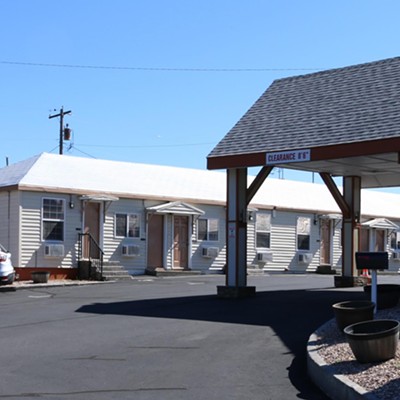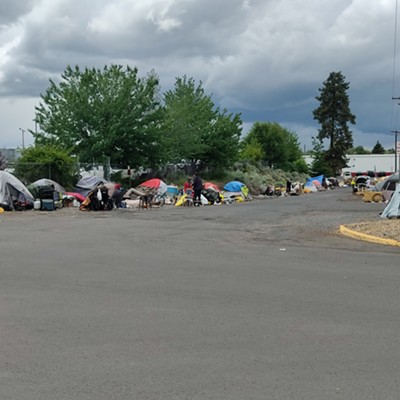[
{
"name": "Air - Ad - Rectangle - 2 pack - Inline Content - 1",
"insertPoint": "1/2",
"component": "16844684",
"requiredCountToDisplay": "6"
}
,{
"name": "Air - Ad - Rectangle - 2 pack - Inline Content - 2",
"insertPoint": "1/4",
"component": "16844686",
"requiredCountToDisplay": "20"
},{
"name": "Air - Ad - Rectangle - 2 pack - Inline Content - 3",
"insertPoint": "3/4",
"component": "16844687",
"requiredCountToDisplay": "17"
}
]
The Bend City Council recently approved an ordinance expanding the civil exclusion zone to cover downtown. We talked to Bend Police Chief Jim Porter to get the inside scoop on how the ordinance came about and how police plan to execute it.
Source Weekly: Where and how did the conversation about expanding the civil exclusion zone begin? Was it initiated by downtown business owners, City Council, or police concerns?
Jim Porter: The Civil Exclusion idea came out of one of the very first meetings we had with the downtown stakeholders group. The example of the exclusion area in the parks was mentioned and the police department moved forward with the concept.
SW: Why is the existing criminal justice process insufficient to address concerns about crime downtown?
JP: We are faced with two challenges with our current justice system: First, the time it takes to adjudicate a crime. For those who commit crimes it often takes up to a year or more before they are held accountable/sentenced. This is no one’s specific fault, the Deschutes County Circuit Court has been asking the state to provide Deschutes County with an additional magistrate for years. Without accountability there is seldom a change in an individual’s misconduct. The ordinance is written in such a manner as to bring accountability in a more reasonable time frame, after clear due process and protection of the individual’s rights.
Secondly, our municipal court is not a court of record, so it does not issue arrest warrants for those who do not appear in court once they’ve been cited. What this means is when we issue a citation, for example: drinking in public or a dog nuisance violation, the person being cited can just ignore the citation. The courts only option at that point is to turn them over to a collection agency.
SW: Who determined which crimes and civil violations should be included in the list of infractions that can result in exclusion?
JP: We used the crimes in the existing exclusion ordinance and added the ordinance addressing drinking on an unlicensed premises and dog nuisances. We have a large volume of complaints in reference to people’s dogs attacking other dogs and people.
SW: How do police determine whether or not to issue an exclusion? Is it automatic for certain violations, or do police have their own bar for when it is warranted?
JP: Like everything we do as the police, we take enforcement action based upon the totality of the circumstances at each incident. We leave the officer with the ability to exercise discretion and good judgement. While this may sound like it gives the officer the authority to play favorites, what it does is avoids the “zero tolerance” mind-set.
SW: How long has the smaller exclusion zone existed? How many people have been excluded in that time? How many
JP: Since 2012. I will attach our stats on the exclusions, crime, and re-offending numbers.
SW: Can you provide a chart of the number of exclusions by type of offense? Do you have a sense of how often a certain violation resulted in an exclusion?
JP: I will include the stats.
SW: How many of those previously excluded have appealed? Have any appeals been successful?
JP: We have had not appeals, and the stats show the number of re-offenders.
SW: Do you have data showing a correlation between the institution of the previous exclusion zone and a decrease in crime?
JP: No, our goal is to remove criminal offenders, those drinking on the streets, and unruly dogs. We want to make the downtown area a safe place at all hours.
SW: What steps have you taken to avoid the kind of legal challenges other cities have faced?
JP: We specifically built in pre-exclusion constitutional protections. Giving those cited due process before they are excluded, by not implementing any exclusion if they chose to appeal. And again, exclusions are only for 90 days. We codified the protection of those who need to be in the downtown area for legitimate reasons: to visit family, business meetings, meet with a lawyer, visit their church, etc.
SW: What kind of data do you plan to collect regarding the exclusion zone moving forward?
JP: Data on all arrests where the exclusion ordinance was used, arrests where it could have been used, and race and sex of those cited.
SW: Can you think of cities where civil exclusion zones have been heralded as a success? What other cities in Oregon (or other places similar to Bend) have them?
JP: What we looked at was the success of the present exclusion area in protecting those visiting our parks. The point I have most heard on this issue is “Bend is Bend.” We have a unique lifestyle and we don’t want to model our downtown after the downtown of Eugene or Portland.
SW: What other approaches has the police department considered or tried?
JP: We intensified patrols in the downtown area and pushed down person crimes and calls for service significantly in 2014, but at a cost of $62,000. We are a department which is operating with minimal staff, with competing important areas of call for service that require officers to respond, and cannot sustain the shift of personnel.
I have been approached by citizens who are convinced this expansion of the exclusion area is directed at those who are forced to panhandle for a living, or hang out, or just sit around; that is not factual. We need to reduce criminal conduct in our downtown. The men and women of the Bend Police Department have an exceptional record of how they treat those most at risk in our community.
Before next summer I will return to the City Council with the results of expansion of the exclusion area and a decision will be made at that time to assess its effectiveness.


























